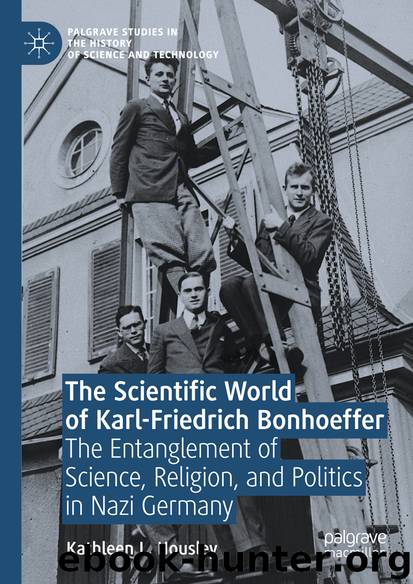The Scientific World of Karl-Friedrich Bonhoeffer by Kathleen L. Housley

Author:Kathleen L. Housley
Language: eng
Format: epub
ISBN: 9783319958019
Publisher: Springer International Publishing
What did Weizsäcker, who knew without a doubt that he was researching a bomb, mean by “a better future”? Strongly influenced by Nazi ideology (his father was a career diplomat under Hitler) even though he himself never joined the party, Weizsäcker spent the rest of his life trying to accept guilt while subtly shifting the blame to the point of becoming blameless. Using obfuscating language was one method of achieving that goal, a method he and Heisenberg practiced from the start. For example, they spoke often of researching a nuclear machine, as if the bomb was a mechanical thing humming and whirling innocently—much like the use of the term gadget by the Allies. They claimed that this machine (actually a breeder reactor) could potentially be used to power submarines. All of this was true. However, the machine could also produce plutonium that could be used in a bomb. This language helped them gain some protective psychological distance, allowing them to dream “of making a better future.”
Rosbaud emphatically trusted Karl-Friedrich as well as Hahn, Mattauch, Strassmann, and von Laue (although as Kramish phrases it, Laue was “the confidant of his lesser secrets”). 37 But he never trusted Heisenberg, finding him egotistical in the extreme. He did not like being in the same room with him, a feeling that was mutual. Nor did he trust Weizsäcker, whom he considered far too close to the Nazis, and who was always whispering in Heisenberg’s ear. This mistrust had taken root in the early 1930s and was solidified by several incidents during the war, including the highly controversial visit of Heisenberg and Weizsäcker with Bohr in occupied Copenhagen in September 1941. In January 1944, Rosbaud wrote to his brother, Hans, about the faculty at the Nazi-dominated University of Strasbourg, of which Weizsäcker was a member: “The physicist is by far the most cunning and diplomatic. His father is the well-known Herr v. W. Give him my best regards. He is a pure theoretician with a strong philosophical inclination, a good friend of Heisenberg. But here too, I keep my distance. . . . I recommend to you to restrict yourself to very objective things, and even there a certain reticence is desirable.” 38
However, at this point before the outbreak of war, Karl-Friedrich and Heisenberg were personal friends as well as colleagues at the University of Leipzig. Karl-Friedrich had known Heisenberg since his time at the Haber Institute when Heisenberg presented his groundbreaking work on quantum mechanics at Nernst’s physics colloquium. Indeed, Karl-Friedrich’s research on molecular hydrogen was built on Heisenberg’s quantum mechanics. At Leipzig, they were heads of different institutes, but they saw each other frequently and were members of the Wednesday club that met on that particular day once a month in Berlin to discuss their research. Karl-Friedrich’s focus had remained on heavy water, even though as has been pointed out already, he was changing course. One of the last papers Karl-Friedrich published before the war was written with J. Hochberg and was titled
Download
This site does not store any files on its server. We only index and link to content provided by other sites. Please contact the content providers to delete copyright contents if any and email us, we'll remove relevant links or contents immediately.
| Africa | Americas |
| Arctic & Antarctica | Asia |
| Australia & Oceania | Europe |
| Middle East | Russia |
| United States | World |
| Ancient Civilizations | Military |
| Historical Study & Educational Resources |
Room 212 by Kate Stewart(5035)
The Crown by Robert Lacey(4722)
Endurance: Shackleton's Incredible Voyage by Alfred Lansing(4676)
The Iron Duke by The Iron Duke(4291)
The Rape of Nanking by Iris Chang(4136)
Joan of Arc by Mary Gordon(4013)
Killing England by Bill O'Reilly(3951)
Say Nothing by Patrick Radden Keefe(3903)
I'll Give You the Sun by Jandy Nelson(3357)
Shadow of Night by Deborah Harkness(3299)
Hitler's Monsters by Eric Kurlander(3268)
Mary, Queen of Scots, and the Murder of Lord Darnley by Alison Weir(3148)
Blood and Sand by Alex Von Tunzelmann(3138)
Darkest Hour by Anthony McCarten(3070)
Eleanor & Park by Rainbow Rowell(3061)
Margaret Thatcher: The Autobiography by Thatcher Margaret(3028)
Red Famine: Stalin's War on Ukraine by Anne Applebaum(2873)
Book of Life by Deborah Harkness(2867)
The One Memory of Flora Banks by Emily Barr(2801)
